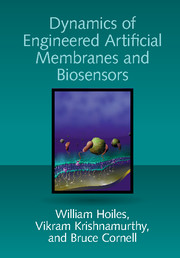Book contents
- Frontmatter
- Contents
- Preface
- List of Abbreviations
- Part I Introduction and Background
- Part II Building Engineered Membranes, Devices, and Experimental Results
- Part III Dynamic Models for Artificial Membranes: From Atoms to Device
- 8 Reaction-Rate-Constrained Models for Engineered Membranes
- 9 Reaction-Rate-Constrained Models for the ICS Biosensor
- 10 Diffusion-Constrained Continuum Models of Engineered Membranes
- 11 Electroporation Models in Engineered Artificial Membranes
- 12 Electroporation Measurements in Engineered Membranes
- 13 Electrophysiological Response of Ion Channels and Cells
- 14 Coarse-Grained Molecular Dynamics
- 15 All-Atom Molecular Dynamics Simulation Models
- 16 Closing Summary for Part III: From Atoms to Device
- Appendices
- Bibliography
- Index
9 - Reaction-Rate-Constrained Models for the ICS Biosensor
from Part III - Dynamic Models for Artificial Membranes: From Atoms to Device
Published online by Cambridge University Press: 25 May 2018
- Frontmatter
- Contents
- Preface
- List of Abbreviations
- Part I Introduction and Background
- Part II Building Engineered Membranes, Devices, and Experimental Results
- Part III Dynamic Models for Artificial Membranes: From Atoms to Device
- 8 Reaction-Rate-Constrained Models for Engineered Membranes
- 9 Reaction-Rate-Constrained Models for the ICS Biosensor
- 10 Diffusion-Constrained Continuum Models of Engineered Membranes
- 11 Electroporation Models in Engineered Artificial Membranes
- 12 Electroporation Measurements in Engineered Membranes
- 13 Electrophysiological Response of Ion Channels and Cells
- 14 Coarse-Grained Molecular Dynamics
- 15 All-Atom Molecular Dynamics Simulation Models
- 16 Closing Summary for Part III: From Atoms to Device
- Appendices
- Bibliography
- Index
Summary
Introduction
Recall that the ion-channel switch (ICS) biosensor is a synthetic biological device built out of an artificial membrane, ion channels, spacers, and tethers. Its purpose is to detect the presence of analyte molecules in fluid. When it senses the presence of analyte molecules, the biosensor responds by changing its electrical impedance significantly. The amount the impedance changes by depends on the concentration of the analyte molecules in the fluid. Therefore, by examining the current flowing through the biosensor, one can detect both the presence of analyte and its concentration.
This chapter studies how the current flowing through the ICS biosensor can be modeled using a two–time scale nonlinear system of ordinary differential equations (for chemical reactions) coupled with the fractional-order macroscopic model of Chapter 8 (for electrical dynamics). The fractional-order macroscopic model of the tethered membrane accounts for both the electrical dynamics of the membrane and the restricted diffusion dynamics at the electrode surface (as detailed in Chapter 8), while the two–time scale nonlinear system of differential equations models the chemical reaction dynamics that occur on the membrane surface of the ICS bisensor. We call the resulting system a reaction-rate-constrained model. Such reaction-rate models are useful for modeling the dynamics of tethered membranes that are excited by potentials less than 50 mV (so that electroporation does not occur).
After developing reaction-rate-constrained models for the ICS biosensor (with μm2 electrode size), we consider biosensors with very small electrodes (area on the order of 1 × 10−12 m2 = μm2).We construct a stochastic model for the current response of such microelectrode ICS (mICS) biosensors as a noisy finite-state Markov chain observed in noise, i.e., a hidden Markov model (HMM), where each state is associated with the number of conducting gramicidin A (gA) dimers.When the electrode size is very small, individual dimer events are recorded – which is a finite-state process – as opposed to the ensemble average of millions of such events in a large electrode, which gives an ordinary differential equation.
The typical current response of the ICS biosensor and mICS biosensor is illustrated schematically in Figure 9.1. All the models in this chapter are validated using realworld experimental data from engineered membranes with different tether densities, lipid compositions, and analyte solutions.
- Type
- Chapter
- Information
- Dynamics of Engineered Artificial Membranes and Biosensors , pp. 159 - 173Publisher: Cambridge University PressPrint publication year: 2018



